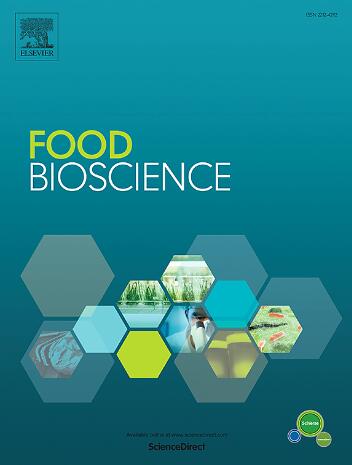Mixed fermentation of citrus peel pomace with Trichoderma koningii, Aspergillus oryzae and Lactobacillus casei: Process optimization, antioxidant activities and non-targeted metabolomics analysis
IF 4.8
1区 农林科学
Q1 FOOD SCIENCE & TECHNOLOGY
引用次数: 0
Abstract
Citrus peel pomace is a waste product after industrial processing, but it is rich in various active ingredients. In this study, a mixture of Trichoderma koningii, Aspergillus oryzae and Lactobacillus casei was used for the fermentation of navel orange peel pomace. The effects of strain ratio, inoculum amount, and fermentation temperature on the total phenolic content (TPC) of navel orange peel pomace were investigated via single-factor test and orthogonal test, and the best process was obtained. The antioxidant activity and non-targeted metabolomics analysis of orange peel pomace by mixed fermentation were performed. The optimal process for mixed fermentation of navel orange peel pomace was identified as follows: inoculation ratio of Trichoderma koningii, Aspergillus oryzae, and Lactobacillus casei was 1:5:7, inoculum amount was 6%, and fermentation temperature was 30 °C. Compared to unfermented navel orange peel pomace, mixed fermentation significantly increased the TPC and antioxidant capacity of navel orange peel pomace, especially in ABTS and FRAP. The non-targeted metabolomics identified 458 differential metabolites, including phenols, flavonoids, terpenoids, alkaloids, phenylpropanoids analogs. Pathway analysis was also performed, and 35 key pathways were identified. The correlation analysis showed that a number of metabolites, such as pinoresinol, gentisic acid, quercetin 3-galactoside 7-rhamnoside, stearidonic acid, quercetin 3-lathyroside, (r) -carvone, were strongly and positively correlated with TPC and antioxidant capacity. To sum up, mixed fermentation could improve the TPC and antioxidant capacity of navel orange peel pomace.
求助全文
约1分钟内获得全文
求助全文
来源期刊

Food Bioscience
Biochemistry, Genetics and Molecular Biology-Biochemistry
CiteScore
6.40
自引率
5.80%
发文量
671
审稿时长
27 days
期刊介绍:
Food Bioscience is a peer-reviewed journal that aims to provide a forum for recent developments in the field of bio-related food research. The journal focuses on both fundamental and applied research worldwide, with special attention to ethnic and cultural aspects of food bioresearch.
 求助内容:
求助内容: 应助结果提醒方式:
应助结果提醒方式:


